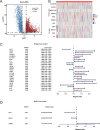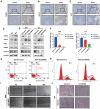CHMP6 as a novel prognostic biomarker in bladder cancer: insights from a comprehensive cell death-related gene risk model
- PMID: 40630215
- PMCID: PMC12234533
- DOI: 10.3389/fonc.2025.1564826
CHMP6 as a novel prognostic biomarker in bladder cancer: insights from a comprehensive cell death-related gene risk model
Abstract
Introduction: Bladder cancer (BLCA) is a prevalent and aggressive disease characterized by substantial molecular heterogeneity, complicating its diagnosis and treatment. Existing therapies, including surgery and chemotherapy, often lack specificity. Alterations in cell death mechanisms, such as ferroptosis, cuproptosis, and immunogenic cell death, significantly impact cancer progression and prognosis.
Methods: We analyzed gene expression data from TCGA and GEO. Cox regression analyses generated a prognostic risk score model incorporating LIPT1, ACSL5, and CHMP6. This model successfully stratified BLCA patients into different risk categories and was validated through survival analysis, immune infiltration, mutation burden assessment, drug sensitivity predictions, and single-cell analysis. The high-risk group was linked to differentiation processes, developmental stages, and active metabolic pathways.
Results: Experimental validation highlighted CHMP6's role in enhancing BLCA cell survival and migration by regulating the cell cycle. The model's prognostic relevance was further supported by drug sensitivity and immune metrics. These results provide valuable insights into potential biomarkers and therapeutic targets for BLCA treatment.
Discussion: The CHMP6 protein promotes BLCA cell survival and invasive migration through modulation of the cell cycle.
Keywords: BLCA; CDRI; CHMP6; ICD; ferroptosis.
Copyright © 2025 Ning, Yang, Wu, Hou, Liu and Yang.
Conflict of interest statement
The authors declare that the research was conducted in the absence of any commercial or financial relationships that could be construed as a potential conflict of interest.
Figures









References
-
- Ferlay J, Soerjomataram I, Ervik M, Dikshit R, Eser S, Rebelo M, et al. GLOBOCAN 2012 v1.0, cancer incidence and mortality worldwide: IARC cancer base no. 11 [Internet. Int Agency Res Cancer Lyon. (2014).
LinkOut - more resources
Full Text Sources

